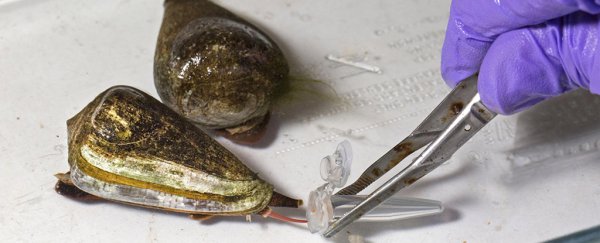To milk a cone snail requires guile and guts.
First, Frank Marí uses a pair of tongs to hold a dead goldfish out to the snail; the creature extends a narrow, hose-shaped nose and sniffs the offering. Then another tube emerges from inside the snail's shell - the proboscis.
This bright orange appendage is long and flexible, with a sharp, harpoon-like tooth at the end, and in some snails it contains enough venom to kill a person in minutes. The proboscis sways, prepares to strike. Swiftly Marí swaps the fish for a latex trap; when the snail stabs the trap, it harmlessly injects the venom into a plastic vial.
Marí gets his "milk". He rewards the snail with the fish. Everyone lives to fight another day.
Marí, a biochemist with the National Institute of Standards and Technology, does not perform this high-stakes exchange just for fun. By studying the components of cone snails' venom, he hopes to uncover compounds that could help cure disease.
This week in the journal Scientific Reports, Marí describes how he and his colleagues used cone snail venom to study receptors in the human immune system.
The research could lead to development of better therapies for tuberculosis and some kinds of cancer, the scientists say.
It's just one of dozens of potential uses for cone snail venom.
In the past year, Marí and his colleagues have published papers on one venom enzyme that can be used to break cell walls and deliver drugs to the body and another that may lead to a new treatment for Parkinson's disease.
A friend of his has discovered a form of cone snail insulin that is even more powerful than human insulin.
This particular snail family is a testament to biology's brilliance - and its utter weirdness, according to Marí.
"These animals are as close as you're going to get to an extraterrestrial," he said.
Marí has been studying these undersea aliens for 15 years at his lab in Charleston, South Carolina.
He calls the aquarium a 'farm', and the snails are basically domesticated livestock. Just like tiny cows, they get 'milked' for venom about once a week.
Unlike cows, they dine on dead fish and deliver a dangerous sting.
"It's a good arrangement for them," Marí said. "They get to be fed with not much effort."
In the early days, he even gave his snails names. There was "Guanábana", named for the sour fruit Marí ate with his students on collecting trips in the Caribbean.
The largest snail in the collection was called "Big". A third was dubbed "Spots" for the speckles on its shell.
Now the farm houses too many snails to be on a first-name basis with all of them, so Marí just refers to each by number. There are more than 60 specimens from 10 species, but the focus of his latest research is Conus purpurascens, the purple cone.
This creature has a fearsome reputation. Though the cone snail is among the slowest animals in the ocean, its venom is so fast-acting that it can nab even swift-swimming fish. First it stuns its prey, then it uses its proboscis to pull the paralysed victim into its gaping mouth.
The purple cone's venom was even used to slay dinosaurs in the second Jurassic Park movie, which Marí says exaggerated the toxic punch of that particular species. To a human, he guessed, the purple cone's sting would probably hurt as much as a bee's - "but I tell you what, I'm not willing to try it", he said with a laugh.
For their latest paper, Marí and his team used a snail venom compound called "conotoxin" as a molecular probe. By disabling certain receptors in cells, the toxin revealed what those receptors are for: promoting an inflammatory reaction.
This knowledge will be useful for scientists seeking treatments for diseases in which those receptors are implicated.
"The application is not just to develop medicine, but to outline the mechanism that allows us to develop an understanding that will eventually have medicinal purposes," Marí explained.
2017 © The Washington Post
This article was originally published by The Washington Post.
